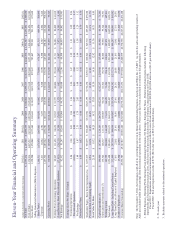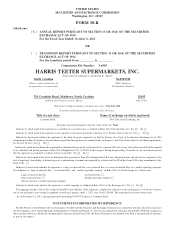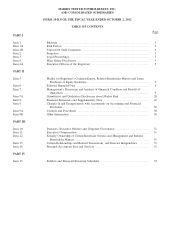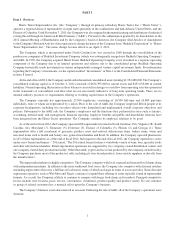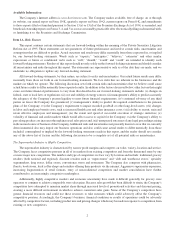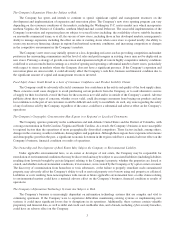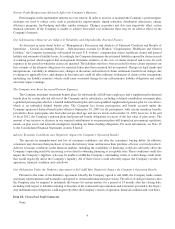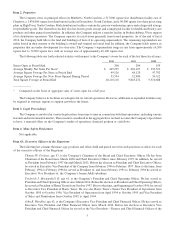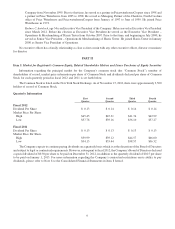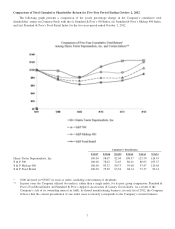Harris Teeter 2012 Annual Report Download - page 6
Download and view the complete annual report
Please find page 6 of the 2012 Harris Teeter annual report below. You can navigate through the pages in the report by either clicking on the pages listed below, or by using the keyword search tool below to find specific information within the annual report.Available Information
The Company’s Internet address is www.harristeeter.com. The Company makes available, free of charge, on or through
its website, our annual report on Form 10-K, quarterly reports on Form 10-Q, current reports on Form 8-K, and amendments
to those reports filed or furnished pursuant to Section 13(a) or 15(d) of the Securities Exchange Act of 1934, as amended, and
beneficial ownership reports on Forms 3, 4, and 5 as soon as reasonably practicable after electronically filing such material with,
or furnishing it to, the Securities and Exchange Commission.
Item 1A. Risk Factors
This report contains certain statements that are forward-looking within the meaning of the Private Securities Litigation
Reform Act of 1995. These statements are not guarantees of future performance and involve certain risks, uncertainties and
assumptions that are difficult to predict. Actual outcomes and results may differ materially from those expressed in, or implied
by, our forward-looking statements. Words such as “expects,” “anticipates,” “believes,” “estimates” and other similar
expressions or future or conditional verbs such as “will,” “should,” “would” and “could” are intended to identify such
forward-looking statements. Readers of this report should not rely solely on the forward-looking statements and should consider
all uncertainties and risks throughout this report. The statements are representative only as of the date they are made, and we
undertake no obligation to update any forward-looking statement.
All forward-looking statements, by their nature, are subject to risks and uncertainties. Our actual future results may differ
materially from those set forth in our forward-looking statements. We face risks that are inherent in the businesses and the
markets in which we operate. The following discussion sets forth certain risks and uncertainties that we believe could cause
actual future results to differ materially from expected results. In addition to the factors discussed below, other factors that might
cause our future financial performance to vary from that described in our forward-looking statements include: (i) changes in
federal, state or local laws or regulations; (ii) cost and stability of energy sources; (iii) management’s ability to predict accurately
the adequacy of the Company’s present liquidity to meet future financial requirements; (iv) continued solvency of any third
parties on leases the Company has guaranteed; (v) management’s ability to predict the required contributions to the pension
plans of the Company; (vi) the Company’s requirement to impair recorded goodwill or other long-lived assets; (vii) changes
in labor and employee benefit costs, such as increased health care and other insurance costs; (viii) ability to recruit, train and
retain effective employees and management; (ix) the extent and speed of successful execution of strategic initiatives; (x)
volatility of financial and credit markets which would affect access to capital for the Company; (xi) the Company’s ability to
pass along product cost increases through increased sales prices and, (xii) unexpected outcomes of any legal proceedings arising
in the normal course of business of the Company.Additional risks and uncertainties not presently known to us or that we currently
deem immaterial also may impair our business operations and also could cause actual results to differ materially from those
included, contemplated or implied by the forward-looking statements made in this report, and the reader should not consider
any of the above list of factors and the following discussion to be a complete set of all potential risks or uncertainties.
The Supermarket Industry is Highly Competitive.
The supermarket industry is characterized by narrow profit margins and competes on value, variety, location and service.
The Company faces competitive pressure in all of its markets from existing competitors and from the threatened entry by one
or more major new competitors. The number and type of competitors we face vary by location and include: traditional grocery
retailers (both national and regional), discount retailers such as “supercenters” and “club and warehouse stores,” specialty
supermarkets, drug stores, dollar stores, convenience stores and restaurants. The Company also competes with pharmacies,
florists, book stores, local coffee shops and retailers offering their products via the internet. Aggressive supercenter expansion,
increasing fragmentation of retail formats, entry of non-traditional competitors and market consolidation have further
contributed to an increasingly competitive marketplace.
Additionally, highly competitive markets and economic uncertainty have made it difficult generally for grocery store
operators to continue to achieve comparable store sales gains. Because sales growth has been difficult to attain, the Company’s
competitors have attempted to maintain market share through increased levels of promotional activities and discount pricing,
creating a more difficult environment in which to achieve consistent sales gains. Some of the Company’s competitors have
greater financial resources and could use these resources to take measures which could adversely affect the Company’s
competitive position. Accordingly, the Company’s business, financial condition or results of operations could be adversely
affected by competitive factors, including product mix and pricing changes which may be made in response to competition from
existing or new competitors.
2


